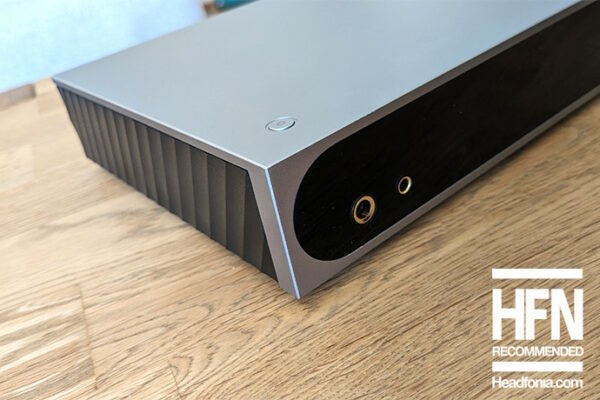Sound and performance:
As the largest member of the brass family, the Tuba is designed to provide the bass backbone of the orchestra, concert, or jazz band. It’s a slightly ungainly instrument being not exactly on the ‘agile’ side of things, and it has a distinctly sonorous timbre. Is this an apt name for Hagerman Audio’s Tuba?
To describe the Tuba’s sonic characteristics succinctly, I can tell you that it sounds dynamically rich, largely uncoloured, and its presentation falls slightly on the ‘relaxed’ side. Unlike the Bottlehead Crack (an OTL design), the Tuba doesn’t impart any additional weight and colour to the lowest octave via my HD600’s, and while not as noticeably ‘euphonic’ as the Crack, it is a more linear and overall faithful signature.
Compared to the Solid State output of the iFi Audio Pro iDSD, The Tuba does take a whisker off the attack and the leading edge of treble detail. This does make for a more relaxing experience with rock music in particular and is noticeable when comparing the percussion and guitars in ‘Ragoo’ by Kings of Leon.
Hagerman advertises the Tuba as being “…extremely non-fatiguing” and I’d have to agree with the manufacturer’s assessment. The EL84 tube harmonics, crossfeed, and various other design tweaks built into the analogue topology by Jim Hagerman make for a slightly gentler presentation compared to a neutral solid-state presentation. This makes for pleasant long listening sessions, but also still packs richness and a hint of warmth to the overall timbre for it to feel different in a tube-y kinda way.

Another factory option that can be chosen for the Tuba is an analogue cross-feed circuit. A quick note on cross feed-for new-comers: unlike listening to loudspeakers in an open room, your ears can’t hear the signal from the opposite ‘side’ when listening to headphones. In certain recordings this can cause an unnatural, over-emphasized left/right stereo effect. Cross-feed allows a slight amount of the opposite signal to be heard in each side of the headphones, which some say creates a slightly more natural and believable sound. I actually didn’t know whether my review unit had the cross-feed option enabled, so I popped-on some early stereo recordings from The Beatles which are usually pretty unlistenable via headphones (and why many prefer the mono mixes). A quick unplug of the left/right cables on my Sennheiser HD600’s and an amp-swap told me that this Tuba does have the cross-feed circuit built-in.
The cross-feed effect is very subtle, and not intrusive or overly discernible during standard playback but in all likelihood does help to contribute to the Tuba’s hugely natural sound that makes you want to keep listening album after album. The cross-feed may also be a contributing factor to the Tuba’s tendency to create a smoother, more blended 3D / spatial image as opposed to the more discernible and ‘place-able’ stereo image on the Chord Mojo.
Click-over to page 3 to read about headphone pairings with the ‘Tuba’.








Hermanni Savolainen
Great review! What are those earpads and head band on your grados. Looks good and super comfy.
Matty
Thanks Hermanni! The headband is from turbulentlabs.com/ and the pads are from beautifulaudio.biz
Hugo
Hey Matty,
Great review and music selection. I kept thinking “wow another great song, so rare to see”. Then saw your bio and it made sense.
I’m awaiting some a12t’s from 64 Audio (13ohms) and had been looking for a sub $1000 tube amp to match. The tuba may be it. Any thoughts on matchability?
Oh also, it seems some text got cut off. End of page 3. “(perhaps its line-level”….
Cheers
Matty
Cheers Hugo, it’s all about music enjoyment at the end of the day! Reputation-aside, I don’t know too much about the impedance curve of the A12t’s, I suspect that a 5 ohm output impedance *might* affect the response. I’d suggest contacting the manufacturer.
Mark
How would this pair with the Beyerdynamic Amiron Home and HD660S?
Thanks!
Matty Graham
I’m sure it’d be a fine match for either – I’d suggest that the 250-ohm Beyer would use the “HI” output, and the 150-ohm Sennheiser would be best matched with the “LO” output to ensure correct frequency response, but it would be interersting to see how the HD660s responds to the higher-impedance output.
Mark
Thank you!
Jim
Thanks for the thoughtful review! I own a Hagerman Audio Labs Castanet (Jim Hagerman’s
first headphone amp) and it’s a great piece of HiFi gear. The Tuba is based on the Castanet ‘s circuit topology but uses different tubes. It’s another excellent product offering outstanding value for the money. And then there’s the 10 year transferable warranty.
Amazing value!